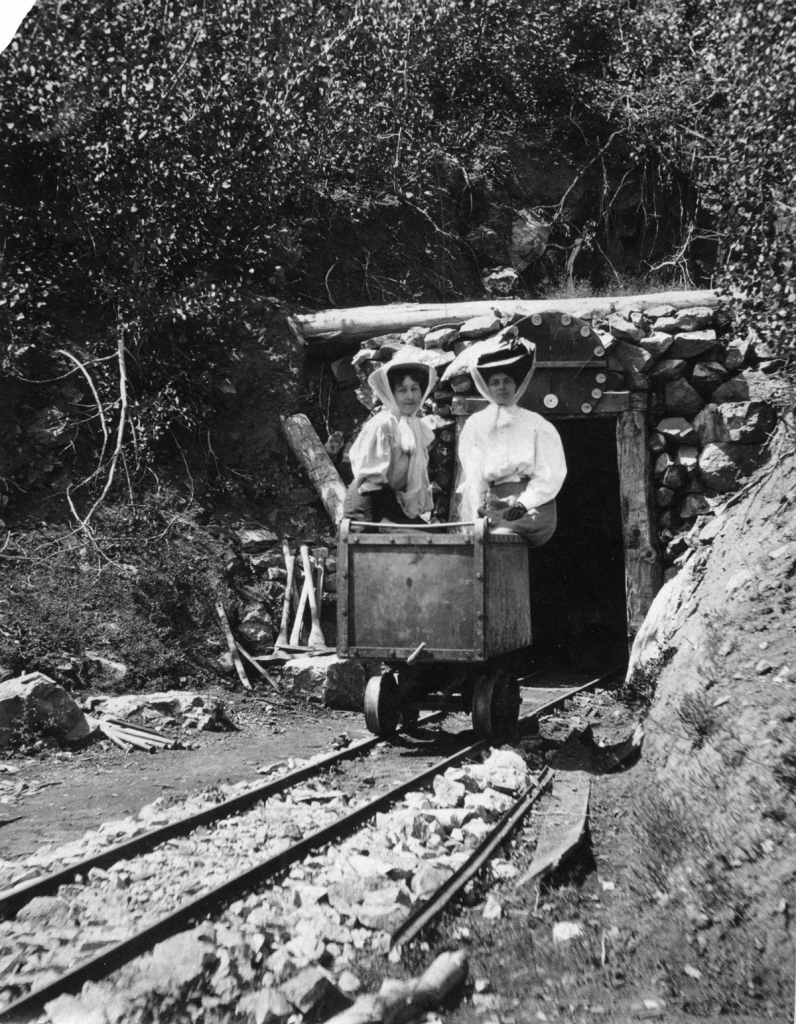In 1894, the Park Record reported on the construction of the Ontario Drain Tunnel #2, noting that throughout the process, Marguerite Keetley, wife of supervisor John Keetley, was rarely “absent from his side.” It was now, the paper said, “her sitting among the men.” And it was in Marguerite’s footsteps that thousands of men walked after the completion of the tunnel. The maiden voyage of the Hearst-funded tunnel was not the last time women were involved in the area’s mining. It’s rare to hear about women underground in Park City, but they supported and worked in the dominant industry.
In 1890, about 11% of women over 10 years of age were employed in the state of Utah, nearly double the percentage of 20 years earlier. Meanwhile in the United States as a whole, about 3% of working women had jobs in agriculture, fisheries, and mining. While they did not do the jobs that generally come to mind when the term “miner” is thrown around, women served the industry as surveyors and mill workers, and by pumping sand into mined-out stopes, making primer for blasting, and breaking rocks.

Credit: Park City Historical Society and Museum, Roslyn Stewart Collection
Yet in Utah, as in much of the country, female laborers were more than discouraged from physically mining hard rock: it was actually illegal, thanks to a court ruling which barred women from working underground. This did not stop Utah mine manager Desdemona Stott Beeson from threatening to wrap a shovel around a laborer’s neck when he refused to leave after being fired from the mine she was in. She managed several mines in the first half of the 20th century along with her husband. After initially pursuing a degree in Psychology, Beeson studied at Stanford during World War I and officially entered the mining industry in 1918. Even though she was prevented from touring mines she was not in charge of, she did supervise her own employees underground. When her husband took a position with the Park City Consolidated Venture, Beeson labored in its construction. She was pregnant at the time.
While other industries were benefitting from the introduction of women into positions traditionally reserved for men, the mining industry took a huge hit during World War II. Laws based on superstition and folk wisdom of the day continued to block access to an ingenious and hardworking labor force. It was not until 1976, decades after Park City’s economic decline began, that women were allowed underground.
The first woman in Park City to mine hard rock underground, Shelley Christiansen, came from a family of miners. She got her start pumping sand, like many women before her. Her career deviated from the gender norm when a foreman asked if she would like to enroll in a training course to become a hard rock miner. Christiansen was hired as a jackleg drill operator in Ontario Mine not long after.
These are just the highlights. Women’s contribution to the mining industry is not relegated to a few names, and has only expanded in recent years.
Sources:
Frederic, Jesup Stimson, Victor Hugo Olmsted, William Mott Steuart, Edward Dana Durand, and Eugene Wilson. Report of the Industrial Commission on Labor Legislation: Including Recommendations as to General Legislation, and Digests of the Laws of the States and Territories Relating to Labor Generally, to Convict Labor, and to Mine Labor, Volume 2; Volume 5. Washington, DC: U.S. Government Printing Office, 1900. Digitized 13 Oct, 2005 by Google. https://books.google.com/books?id=qzN53Cl87DsC&dq=1897,+utah,+mining,+women&source=gbs_navlinks_s
Ison, Yvette D., “Desdemona Stott Beeson was Determined to Work in Mining.” History Blazer. Sep 1995. http://historytogo.utah.gov/utah_chapters/mining_and_railroads/desdemonastottbeesonwasdeterminedtowork.html
Justia “Holden v. Hardy.” Accessed March 25, 2015.
Rogers-Iversen, Kristen. “Utah Woman was a Mining Pioneer,” Salt Lake Tribune. 25 Nov, 2010.
Ringholz, Raye Carleson, K. C. Muscolino, and Harry Harpster. Diggings & Doings in Park City. Park City, UT: R.C. Ringholz, 1983.
Strack, Don. UtahRails.net “Park City Drain Tunnels” Last modified March 22, 2014.
Thomas, Daniel Lindsey and Lucy Blaney Thomas. Kentucky Superstitions. Princeton, NJ: Princeton University Press, 1920. http://chestofbooks.com/fairy-tale/Kentucky-Superstitions/index.html#.VPi9GHzF_Hg
United States Department of Labor, Bulletin of the Department of Labor. Washington, DC: G.P.O., 1898. Digitized by Google. https://books.google.com/books?id=NMxGAQAAIAAJ&dq=1897,+utah,+mining,+women&source=gbs_navlinks_s
United States Department of Labor, Bulletin of the Department of Labor, Volume 2, Issues 8-13. Washington DC: US Government Printing Office, 1897.
Whitley, Colleen, ed. From the Ground Up: A History of Mining in Utah. Logan, UT: Utah State University Press, 2006.